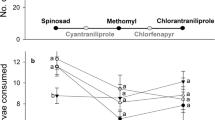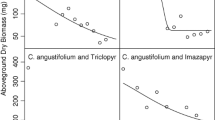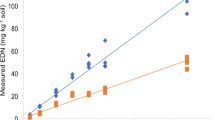Abstract
Weed resistance to glyphosate and development of new GM crops tolerant to 2,4-dichlorophenoxyacetic acid (2,4-D) and dicamba is expected to lead to increased use of these herbicides in cropland. The lady beetle, Coleomegilla maculata is an important beneficial insect in cropland that is commonly used as an indicator species in safety evaluations of pesticides. Here, we examined the lethal and non-lethal effects of 2,4-D and dicamba active ingredients and commercial formulations to this lady beetle species, and tested for synergistic effects of the herbicides. Second instars of lady beetles were exposed to an experimental treatment, and their mortality, development, weight, sex ratio, fecundity, and mobility was evaluated. Using similar methods, a dose–response study was conducted on 2,4-D with and without dicamba. The commercial formulation of 2,4-D was highly lethal to lady beetle larvae; the LC90 of this herbicide was 13 % of the label rate. In this case, the “inactive” ingredients were a key driver of the toxicity. Dicamba active ingredient significantly increased lady beetle mortality and reduced their body weight. The commercial formulations of both herbicides reduced the proportion of males in the lady beetle population. The herbicides when used together did not act synergistically in their toxicity toward lady beetles versus when the chemistries were used independently. Our work shows that herbicide formulations can cause both lethal and sublethal effects on non-target, beneficial insects, and these effects are sometimes driven by the “inactive” ingredients. The field-level implications of shifts in weed management practices on insect management programs should receive further attention.


Similar content being viewed by others
References
Agarwala BK, Bardhanroy P, Yasuda H, Takizawa T (2001) Prey consumption and oviposition of the aphidophagous predator Menochilus sexmaculatus (Coleoptera: Coccinellidae) in relation to prey density and adult size. Environ Entomol 30:1182–1187
Antwi FB, Peterson RKD (2009) Toxicity of δ-phenothrin and resmethrin to non-target insects. Pest Manag Sci 65:300–305
Aronzon CM, Sandoval MT, Herkovits J, Pérez-Coll CS (2011) Stage-dependent toxicity of 2,4-dichlorophenoxyacetic on the embryonic development of a South American toad, Rhinella arenarum. Environ Toxicol 26:373–381
Bautista SL (2007) A summary of acute risk of four common herbicides to birds and mammals. In: Harrington TB, Reichard SH (eds) Meeting the challenge: invasive plants in Pacific Northwest ecosystems. U.S. Department of Agriculture, Forest Service, Portland, OR, pp 77–82
Behrens MR, Mutlu N, Chakraborty S, Dumitru R, Jiang WZ, LaVallee BJ, Herman PL, Clemente TE, Weeks DP (2007) Dicamba resistance: enlarging and preserving biotechnology-based weed management strategies. Science 316:1185–1188
Biddinger DJ, Weber DC, Hull LA (2009) Coccinellidae as predators of mites: stethorini in biological control. Biol Control 51:268–283
Bohnenblust E, Egan JF, Mortensen D, Tooker JF (2013) Direct and indirect effects of the synthetic-auxin herbicide dicamba on two lepidopteran species. Environ Entomol 42:586–594
Bradberry M, Watt BE, Proudfoot AT, Vale JA (2000) Mechanisms of toxicity, clinical features, and management of acute chlorophenoxy herbicide poisoning: a review. Clin Toxicol 38:111–122
Ciarlo TJ, Mullin CA, Frazier JL, Schmehl DR (2011) Learning impairment in honey bees caused by agricultural spray adjuvants. PLoS One 7:e40848
Correia FV, Moreira JC (2010) Effects of glyphosate and 2,4-D on earthworms (Eisenia foetida) in laboratory tests. Bull Environ Contam Toxicol 85:264–268
Cousin M, Silva-Zacarin E, Kretzschmar A, El Maataoui M, Brunet J-L, Belzunces LP (2013) Size changes in honey bee larvae oenocytes induced by exposure to paraquat at very low concentrations. PLoS One 8:e65693
Cowles RS, Cowles EA, McDermott AM, Ramoutar D (2000) “Inert” formulation ingredients with activity: toxicity of trisiloxane surfactant solutions to twospotted spider mites. J Econ Entomol 93:180–188
Cox C (1999) Inert ingredients in pesticides: who’s keeping secrets? J Pesticide Reform 19:1–7
Cox C, Surgan M (2008) Unidentified inert ingredients in pesticides: implications for human and environmental health. Environ Health Perspect 114:1803–1806
Desneux N, Decourtye A, Delpuech JM (2007) The sublethal effects of pesticides on beneficial arthropods. Annu Rev Entomol 52:81–106
Duan JJ, Head G, McKee MJ, Nickson TE, Martin JH, Sayegh FS (2002) Evaluation of dietary effects of transgenic corn pollen expressing Cry3Bb1 protein on a non-target ladybird beetle, Coleomegilla maculata. Entomol Exp Appl 104:271–280
Dunkel FV, Richards DC (1998) Effect of an azadirachtin formulation on six nontarget aquatic macroinvertebrates. Environ Entomol 27:667–674
Egan JF, Bohnenblust E, Goslee S, Mortensen D, Tooker JF (2014) Herbicide drift can affect plant and arthropod communities. Agr Ecosyst Environ 185:77–87
Evans EW (2009) Lady beetles as predators of insects other than Hemiptera. Biol Control 51:255–267
Green JM (2009) Evolution of glyphosate-resistant crop technology. Weed Sci 57:108–117
Hayes T, Haston K, Tsui M, Hoang A, Haeffele C, Vonk A (2002) Herbicides: feminization of male frogs in the wild. Nature 419:895–896
Hodek I, Honěk A (2009) Scale insects, psyllids, and whiteflies (Hemiptera: Sternorrhyncha) as prey of ladybirds. Biol Control 51:232–243
Honěk A (1993) Intraspecific variation in body size and fecundity in insects: a general relationship. Oikos 66:483–492
Howe CM, Berrill M, Pauli BD, Helbing CC, Werry K, Veldhoen N (2004) Toxicity of glyphosate-based pesticides to four North American frog species. Environ Toxicol Chem 23:1928–1938
Iperti G (1999) Biodiversity of predaceous Coccinellidae in relation to bioindication and economic importance. Agr Ecosyst Environ 74:323–342
James DG (2003) Synthetic herbivore-induced plant volatiles as field attractants for beneficial insects. Environ Entomol 32:977–982
Kazmer DJ, Luck RF (1995) Field tests of the size-fitness hypothesis in the egg parasitoid Trichogramma pretiosum. Ecology 76:412–425
Krogh KA, Halling-Sørensen B, Mogensen BB, Vejrup KV (2003) Environmental properties and effects of nonionic surfactant adjuvants in pesticides: a review. Chemosphere 50:871–901
Lacoume S, Bressac C, Chevrier C (2009) Male hypofertility induced by paraquat consumption in the non-target parasitoid Anisopteromalus calandrae (Hymenoptera: Pteromalidae). Biol Control 49:214–218
Levine TE (1996) The regulation of inert ingredients in the United States.: Pesticide Formulation and Adjuvant Technology (ed. by CL Foy & DW Pritchard). CRC Press, Boca Raton, pp 1–12
Lundgren JG, Wiedenmann RN (2002) Coleopteran-specific Cry3Bb toxin from transgenic corn pollen does not affect the fitness of a non-target species, Coleomegilla maculata DeGeer (Coleoptera: Coccinellidae). Environ Entomol 31:1213–1218
Lundgren JG, Gassmann AJ, Bernal JS, Duan JJ, Ruberson JR (2009) Ecological compatibility of GM crops and biological control. Crop Prot 28:1017–1030
Lundgren JG, Moser SE, Hellmich RL, Seagraves MP (2011) The effects of diet on herbivory by a predaceous lady beetle. Biocontrol Sci Technol 21:71–74
Mann RM, Bidwell JR (1999) The toxicity of glyphosate and several glyphosate formulations to four species of southwestern Australian frogs. Arch Environ Contam Toxicol 36:193–199
Mann RM, Hyne RV, Choung CB, Wilson SP (2009) Amphibians and agricultural chemicals: a review of the risks in a complex environment. Environ Pollut 157:2903–2927
Martinez IM, Lumaret J-P, Cruz MR (2001) Suspected side effects of a herbicide on dung beetle populations (Coleoptera: Scarabaeidae). C R Acad Sci III 324:989–994
Meled M, Thrasyvoulou A, Belzunces LP (1998) Seasonal variations in susceptibility of Apis mellifera to the synergistic action of prochloraz and deltamethrin. Environ Toxicol Chem 17:2517–2520
Michaud JP, Vargas G (2010) Relative toxicity of three wheat herbicides to two species of Coccinellidae. Insect Sci 17:434–438
Mortensen DA, Egan JF, Maxwell BD, Ryan MR, Smith RG (2012) Navigating a critical juncture for sustainable weed management. Bioscience 62:75–84
Morton HL, Moffett JO, MacDonald RH (1972) Toxicity of herbicides to newly emerged honey bees. Environ Entomol 1:102–104
Mullin CA, Chen J, Fine JD, Frazier MT, Frazier JL (2015) The formulation makes the honey bee poison. Pestic Biochem Physiol 120:27–35
NASS (2015) National Agriculture Statistics Service: USDA
Ness JH, Bronstein JL, Andersen AN, Holland JN (2004) Ant body size predicts dispersal distance of ant-adapted seeds: implications of small-ant invasions. Ecology 85:1244–1250
Obrycki JJ, Harwood JD, Kring TJ, O’Neil RJ (2009) Aphidophagy by Coccinellidae: application of biological control in agroecosystems. Biol Control 51:244–254
O’Connell DM, Wratten SD, Pugh AR, Barnes A-M (2012) ‘New species association’ biological control? Two coccinellid species and an invasive psyllid pest in New Zealand. Biol Control 62:86–92
Oliver JB, Reding ME, Moyseenko JJ, Klein MG, Mannion CM, Bishop B (2006) Survival of adult Tiphia vernalis (Hymenoptera: Tiphiidae) after insecticide, fungicide, and herbicide exposure in laboratory bioassays. J Econ Entomol 99:288–294
Pereira JL, Antunes SC, Castro BB, Marques CR, Gonçalves AMM, Gonçalves F, Pereira R (2009) Toxicity evaluation of three pesticides on non-target aquatic and soil organisms: commercial formulation versus active ingredient. Ecotoxicology 18:455–463
Pilling ED, Jepson PC (1993) Synergism between EBI fungicides and a pyrethroid insecticide in the honeybee (Apis mellifera). Pest Sci 39:293–297
Pilorget L, Buckner J, Lundgren JG (2010) Sterol limitation in a pollen-fed omnivorous lady beetle (Coleoptera: Coccinellidae). J Insect Physiol 56:81–89
Shaner DL (2000) The impacct of glyphosate-tolerant crops on the use of other herbicides and on resistance management. Pest Manag Sci 56:320–326
Sivey JD, Roberts AL (2010) Abiotic reduction reactions of dichloroacetamide safeners: transformations of “inert” agrochemical constituents. Environ Sci Technol 46:2187–2195
Stahlman PW, Phillips WM (1979) Inhibition of glyphosate phytotoxicity. Weed Sci 27:575–577
Stark JD, Vargas R, Banks JE (2007) Incorporating ecologically relevant measures of pesticide effect for estimating the compatibility of pesticides and biocontrol agents. J Econ Entomol 100:1027–1032
Surgan M, Condon M, Cox C (2010) Pesticide risk indicators: unidentified inert ingredients compromise their integrity and utility. Environ Manage 45:834–841
Tominack RL (2000) Herbicide formulations. Clin Toxicol 38:129–135
Yi SA, Francis BM, Jarrell WM, Soucek DJ (2011) Toxicological effects of the aquatic herbicide, fluridone, on male water mites (Hydrachnidae: Arrenurus: Megaluracarus). Ecotoxicology 20:81–87
Zhu W, Schmehl DR, Mullin CA, Frazier JL (2014) Four common pesticides, their mixtures and a formulation solvent in the hive environment have high oral toxicity to honey bee larvae. PLoS One 9:e77547
Acknowledgments
This research was supported by institutional contributions by the authors.
Author information
Authors and Affiliations
Corresponding author
Ethics declarations
Conflict of interest
J.G.L. has sold predatory beetles to Monsanto for safety research, and received honoraria for speaking at Beyond Pesticides and various Conservation Agriculture and Pollinator-related groups. L.F. has no conflicts of interest to report.
Rights and permissions
About this article
Cite this article
Freydier, L., Lundgren, J.G. Unintended effects of the herbicides 2,4-D and dicamba on lady beetles. Ecotoxicology 25, 1270–1277 (2016). https://doi.org/10.1007/s10646-016-1680-4
Accepted:
Published:
Issue Date:
DOI: https://doi.org/10.1007/s10646-016-1680-4




